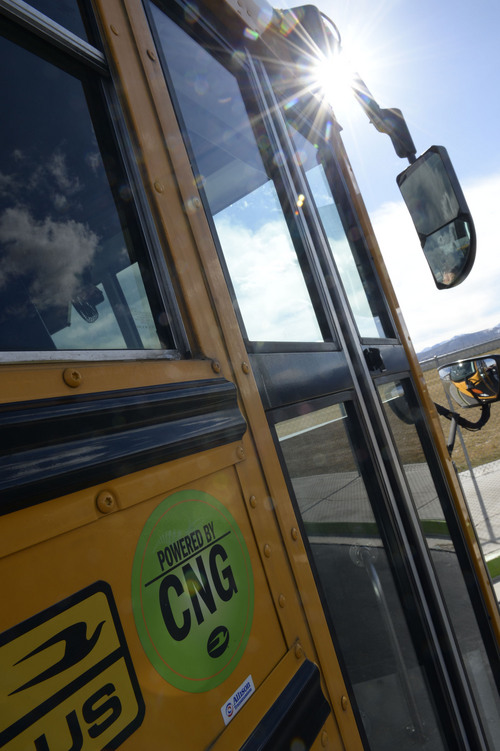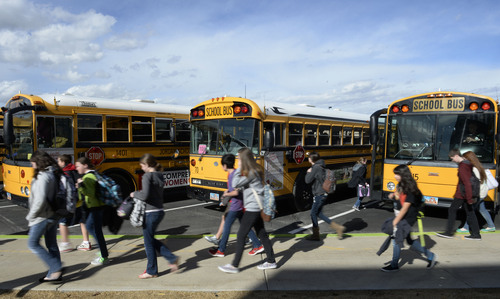This is an archived article that was published on sltrib.com in 2014, and information in the article may be outdated. It is provided only for personal research purposes and may not be reprinted.
The oldest school bus in the state sits in a garage near a junior high in scenic Eden. This year, the bus turns 30 — older than some students' parents.
"It doesn't get used a whole lot," said Weber School District spokesman Nate Taggart, noting it only traveled 591 miles last year as a spare bus.
Still, it's one tiny part of what many say is a big problem for Utah — an aging fleet of school buses spewing toxic gases into the state's already-sullied winter air.
About 37 percent of all the state's school buses were made in 2001 or earlier, according to the state Office of Education, meaning they don't meet current Environmental Protection Agency (EPA) standards.
Of those dirty Utah buses, two-thirds are in "nonattainment" areas, places that don't meet federal air-quality standards.
In all, more than 1,000 of the state's more than 2,800 school buses are 13 years old or older. According to the EPA, new buses emit 95 percent less pollution than those built before 2007.
The Davis School District is the worst offender with 146 old buses — more than half of its fleet. The Weber district has the next highest number of old buses at 83, followed by Alpine with 82.
Clean-air advocates hope lawmakers pass HB41, which seeks to give schools $20 million in matching grants to buy new cleaner buses.
"The really dirty, old school buses are just a liability for everyone," said Cherise Udell, founder of Utah Moms for Clean Air. "They're a liability for the state, for the children riding them, for the bus drivers, just because they're so polluting."
—
A health issue • Udell said her two girls rarely ride buses. They live close enough to their Salt Lake City school that they can usually walk or bike.
But when they do board buses for field trips, it makes her nervous, especially when the buses idle.
"It drives me crazy that my kids are sitting there in this cancer-causing cloud of smoke," Udell said.
She and other parents have reason to be concerned, said Brian Moench, president of Utah Physicians for Healthy Environment.
"There are a number of studies that show that not only are the diesel buses a problem for community-wide air pollution," he said, "but they're an even bigger problem for the children sitting inside these diesel buses."
Moench said the concentration of diesel exhaust inside school buses may be as much as four to eight times higher than outside the buses. He said exposure to air pollution has been linked with lower intelligence, behavior problems and autism in children.
"Kids who arrive at school having ridden in one of these buses are being forced to endure, for the duration of that bus ride, basically an intense red alert pollution day," he said.
Rep. Stephen Handy, R-Layton, is sponsoring HB41 and calls the number of old buses in use "a huge concern."
—
Money vs. clean air • Handy's district includes the Davis School District, the second-largest school district in the state. It has the highest number of old, dirty buses and is in a nonattainment area.
In 2008, Davis bought 23 new buses. But the district just hasn't been able to buy as many new buses since the recession, said Chris Williams, a Davis spokesman, and the number dropped to about five a year in recent years.
The district has, however, tried to reduce pollution by retrofitting many of its buses and prohibiting bus drivers from idling.
Weber district also has struggled to replace old buses in recent years.
Taggart said the state funds only about 65 percent of the district's transportation program, "so anytime that you're purchasing new buses, that's got to come either from funding that would go to other educational sources or out of our capital outlay funds, and there have been some tight years since the recession."
It's a common sentiment across the state.
New, large diesel buses can cost about $100,000 to $120,000 and last about 15 years, according to the state Office of Education.
—
Alternative fuel • Compressed natural gas buses can each save districts about $2,700 to $4,500 a year in fuel costs.
But they cost about $25,000 more than diesel buses, meaning it takes at least a few years to recover that extra expense before districts can start saving cash.
Only 3 percent of school buses in the state now run on compressed natural gas, and the vast majority of those are in the Jordan and Canyons districts. Canyons has 18 compressed natural gas buses. Jordan has 71, which save the district an estimated $483,747 a year on fuel, said Steve Dunham, a Jordan spokesman.
Dunham said the district regularly seeks grants to help pay for those buses, and it takes the district about 3½ years before the buses start saving money.
"Why not spend a little bit extra when in the long run it's going to be good for your taxpayers and good for the environment," Dunham said.
But even Jordan can't afford all natural-gas buses.
"If we were to buy all natural-gas vehicles," said Herb Jensen, Jordan transportation director, "we wouldn't be able to purchase the number of vehicles we need to keep up with the growth [of the district]."
—
A 'game changer?' • Handy's bill would allow school districts to apply for grants to buy new buses that run on either diesel or alternative fuels. Schools would have to match the money.
The measure has attracted 36 cosponsors, easily passed the House and is moving through the Senate. The governor has said he wants to clean up school buses as part of his budget recommendations.
The main question is how much money lawmakers will be willing to put toward it. Handy's suggested $20 million, along with $20 million in matching funds from districts, could replace about 170 old, dirty buses, he said.
The governor, however, has recommended about $14 million be put toward cleaning up buses and other state fleet vehicles. And a legislative education budget committee has made an early recommendation that the effort get $10 million.
In recent years, the state retrofitted more than 1,000 old buses to make them cleaner, said Murrell Martin, pupil transportation specialist at the state Office of Education. But even retrofitted buses aren't as clean as new ones, he said.
"The 170 buses is not a game changer in terms of clean air," Handy said, "but it is very, very symbolic because it shows the community-wide commitment ... that we want to do our part to help clear the air." —
What's next?
HB41 has passed the House and faces only a third and final vote on the Senate floor.











